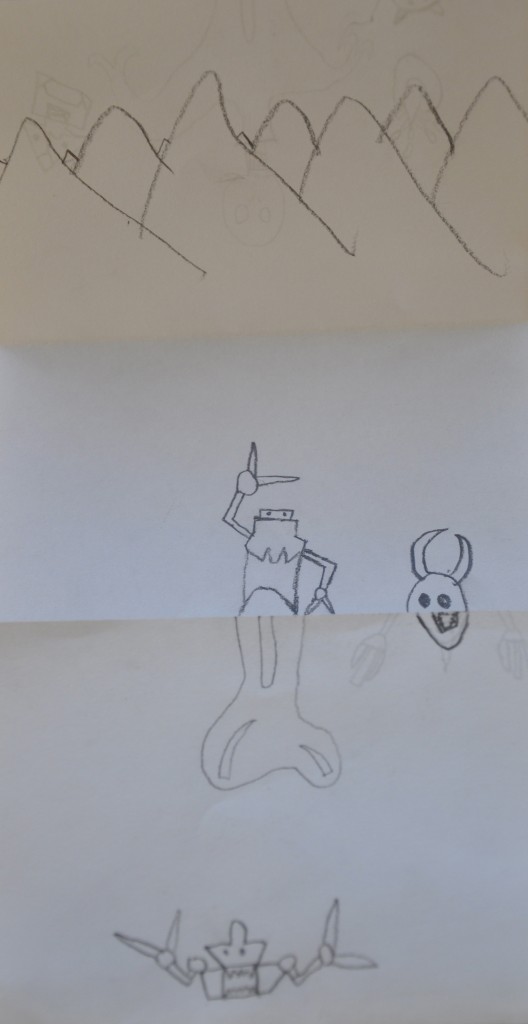Child-made Flapbooks Present and Past: A Research Project

Children’s flap books (or turn-up books) date back to the mid 17th century. The earliest forms did not distinguish between an adult and child audience, but were situated as part of a larger folk culture. The oldest known flap book, The Beginning Progress and End of Man was published in London in 1650.
The design was a single sheet of paper divided into four panels. Each panel consisted of two flaps that lifted up or down transforming Biblical and moral images into fabulous creatures — Adam into Eve, then a mermaid; a lion into a Griffin, then into an Eagle with a child; a young man with a heart and money bag; but always ending with a rich miser who becomes a skeleton.
Early flap books bore a similarity to chap books.
They were made with a single sheet of inexpensive paper with crude woodcuts and addressed to a wide audience. In the latter part of the 18th century, flap books became associated with popular culture events of the era such as puppet shows, circus performances, and pantomimes.
The religious flap book was modified, extended, and re/titled Metamorphosis, and published in America from the late 18th to late 19th century. By this time, the book was directed specifically to children and designed as a literacy text that included letters, numerals, and images.
It appears as if children engaged in making versions of flap books from the late 17th century in both England and America. Researchers are not entirely clear how many domestically produced flap books were created by children. What we do know is that the domestically produced versions closely resemble the existing religious text in both image and structure. Fortunately, some historical versions include children’s names, ages, and dates, and this helps to identify children as authors and creators.
What is clear is that children in history engaged with literacy activities that included simple book making. After more than 300 years from the first known child-made flap book, do children continue to find the simple design appealing? In February of 2014, a small group of researchers from The Pennsylvania State University made two visits to an after-school program to find an answer to this question.
Children, ages 6-11, were provided with an identical design to the historical texts: a single sheet of paper with pre-cut flaps. During the first visit, emphasis was placed on the idea of transformation. On the first visit the children were provided with a single panel and were encouraged to orient the paper vertically, rather than horizontally, so that the top would lift upward and the bottom flap would lift downward. Similar to children in the 17th to 19th centuries, the contemporary children’s drawings mirrored themes and sources of imagery which were prevalent in the visual and material cultures that make up their experiences. For example, while it is believed that historical children used the existing flap books as models for their own creations, contemporary children used library books, film and television, and each other to frame both content and style of their work. Themes of pirates, monsters, mermaids, princesses, snowmen, and Star Wars were prominent choices.
Robotic Pirates, Single Panel, Boy Age 11.
Snowman Melting, Single Panel, Girl Age 6.
Girl to Mermaid Transformation, Single Panel, Girl Age 6.
On the second visit, the children were provided with a single sheet of paper that was configured into a simple, four-panel accordion book. The children were reminded of the previous visit by reviewing their single-panel drawings. Additionally, the children were shown two example texts that featured dinosaurs participating in the winter Olympics and forest animals gathering together for a winter party.
The children needed very little instruction and went to work immediately. Content themes from the first week remained constant, and the children were excited to explore their ideas in a familiar, but extended, format.
Pirates, Monsters, Robots, Four Panel Accordion Fold, Boy Age 11.
Princesses, 4 Panel Accordion Fold, Girl Age 6.
The work in the after-school program revealed the timeless and exciting nature of the simple flap book. Paper, pencils, and markers offered children from the 21st century an opportunity to explore literacy in similar ways as children who lived centuries before them. It also demonstrated the enduring appeal of the fantastic: mermaids, skeletons, and the unusual configurations that come with simple transformations.
Jacqueline Reid-Walsh, Kris Sunday, and Laura D’Aveta











